Lest we forget...
Discussion
Saddle bum said:
Big Pants said:
My great uncle died there, aged 19, as part of an artillery battalion. The war graves (and the endless - well, 3 summers long - pre-internet search for his during my childhood, led by my parents) have remained a profound influence on me. Every school child, adult, warmonger, gun owner, Donald Trump and believer that an isolationist political view will somehow leave GB immune to world conflict should be made to visit. Even now those acres of immaculately kept white gravestones give me pause for thought. We will never forget.
I don't want to start an off-topic spat, but - gun owners do not start wars. History shows that those who are proficient with firearms are the first to be shipped off to the front.In short - "If you don't trust me to have a gun in peacetime, don't try and give me one when a war starts".
In addition, I lost two uncles in WW1 and several members were severely injured in WW2.
A very distinct difference. I imagine those in WWI were the former.
Horrible horrible things guns, if you offered that I could keep one at home I'd hand it back.
On topic... I've been to Tyne Cot etc. I cried at Tyne Cot I'll admit to that.
Recently returned from a week in this area visiting some of these sites (including a great uncle's grave). We stayed at a B&B in Ypres run by the grandson of a stonemason who was heavily involved in the rebuilding of the town and construction of the Menin Gate.
His grandfather carved the lions on the top (in situ!) and worked from 1920 to 1967 rebuilding the town as it had been prior to the war.
Apparently the church had a flat roof prewar, but the town told the Germans (who paid for all the rebuilding) that it had a massive spire... And so one was built!
It's interesting (and somewhat saddening) to compare the Allied and German cemeteries. The German ones are very plain and few in number now - they were consolidated into only 14 cemeteries over several decades, with multiple soldiers commemorated on each cross.
His grandfather carved the lions on the top (in situ!) and worked from 1920 to 1967 rebuilding the town as it had been prior to the war.
Apparently the church had a flat roof prewar, but the town told the Germans (who paid for all the rebuilding) that it had a massive spire... And so one was built!
It's interesting (and somewhat saddening) to compare the Allied and German cemeteries. The German ones are very plain and few in number now - they were consolidated into only 14 cemeteries over several decades, with multiple soldiers commemorated on each cross.
rscott said:
It's interesting (and somewhat saddening) to compare the Allied and German cemeteries. The German ones are very plain and few in number now - they were consolidated into only 14 cemeteries over several decades, with multiple soldiers commemorated on each cross.
I completely agree.We visited a German cemetry. The "density" was 10 times that of a British, or Commonwealth cemetry. In fact, we saw one spot that is half the size of my modest lawn.
It contained the remains of 25,000 Germans.
It is the rectangle half way down the right hand side of the cemetry.
https://www.google.co.uk/maps/place/German+War+Cem...
The rest of the cemetry contains over 19,000 bodies.
A British cemetry of this size would contain about 4,000 bodies.
After the war, the Germans were told to remove most of their cemetries. The French and Belgians wanted to use the land for agriculture.
I believe that the Germans had to buy land to provide burial spaces. They didn't have much money. They had smaller cemetries all over the battlefields, but the Belgians and the French were not going let good agricultural land go to waste on the Bosch.
So, the bodies were exhumed and reburied where the Germans could buy a bit of land.
In the allied cemetries, the dominant colour is white. In the German cemetries the dominant colour is black.
The allied cemetries are very sad places to be, but the German cemetries are just desolate.
May I ask which cemetry your great uncle was buried in?
He's in the Dickebusch New Military Cemetery Extension ( http://www.cwgc.org/find-a-cemetery/cemetery/50901... ) . We only found this out while visiting Thiepval - his full details were only added to the CWGC website this year.
I'm trying to track down the USB stick with my photos - I've some of this cemetery and also the two German ones we visited.
I think the most overwhelming aspect of the visit was the sheer number of Allied cemeteries. There's a CWGC app which shows cemeteries within 5km of your current location - at times the map was almost completely covered by cemetery markers.
I'm trying to track down the USB stick with my photos - I've some of this cemetery and also the two German ones we visited.
I think the most overwhelming aspect of the visit was the sheer number of Allied cemeteries. There's a CWGC app which shows cemeteries within 5km of your current location - at times the map was almost completely covered by cemetery markers.
don4l said:
We visited a German cemetry. The "density" was 10 times that of a British, or Commonwealth cemetry. In fact, we saw one spot that is half the size of my modest lawn.
It contained the remains of 25,000 Germans.
It is the rectangle half way down the right hand side of the cemetry.
https://www.google.co.uk/maps/place/German+War+Cem...
Some research has recently uncovered the fact that there are two British Tommies also resting in the mass grave at Langemarck. There is a small plaque with their names on attached to one of the German plinths: linkIt contained the remains of 25,000 Germans.
It is the rectangle half way down the right hand side of the cemetry.
https://www.google.co.uk/maps/place/German+War+Cem...
Personally I find the German cemeteries pretty foreboding places compared to the English country garden feel of the CWGC cemeteries. We've visited just about all the cemeteries in the salient and some of the most peaceful ones are the tiny battle sites well off the 'tourist' track, often with less than 30-40 burials, all immaculately kept as you'd expect.
43034 said:
BBC interviewed a load of WW1 soldiers in the 60s, hundreds(?) of hours of footage.
Can't remember the name, does anyone know it? Or know where I can find it?
Cheers
Is this it?Can't remember the name, does anyone know it? Or know where I can find it?
Cheers

https://www.youtube.com/watch?v=po3OZyVLHTM&li...
There is another one which I cannot find at the moment. I will keep looking and post again when I find it.
EDIT:-
This is the one that I was thinking of:-
https://www.youtube.com/watch?v=OtyWXDw4S0U
Edited by don4l on Thursday 20th October 09:47
rednotdead said:
Some research has recently uncovered the fact that there are two British Tommies also resting in the mass grave at Langemarck. There is a small plaque with their names on attached to one of the German plinths: link
Personally I find the German cemeteries pretty foreboding places compared to the English country garden feel of the CWGC cemeteries. We've visited just about all the cemeteries in the salient and some of the most peaceful ones are the tiny battle sites well off the 'tourist' track, often with less than 30-40 burials, all immaculately kept as you'd expect.
If you think the WW1 German cemeteries are 'foreboding', there's a Russian WW2 military cemetary near Bergen-Belsen. Lohheide, I think it's called. Estimates say 50,000 Russian/Soviet POWs are buried in mass graves a short walk from the concentration camp. It is the single most desolate place I've ever stood in, dark, foreboding, and utterly devoid of any of the joyous sounds of nature.Personally I find the German cemeteries pretty foreboding places compared to the English country garden feel of the CWGC cemeteries. We've visited just about all the cemeteries in the salient and some of the most peaceful ones are the tiny battle sites well off the 'tourist' track, often with less than 30-40 burials, all immaculately kept as you'd expect.
Found accidentally while walking to visit Bergen-Belsen during a 'maintenance day' in the middle of an exercise on Hohne ranges. Sorry that it's off on a tangent from the WW1 focus of the thread.
In the UK it's worth visiting Royal Victoria Country Park, Netley, Hampshire. Formerly a Military Hospital, tucked away in the corner of the site is a military cemetery where hospital patients, from both sides of the front line, who succumbed to their injuries, were buried...

...all that remains of that enormous hospital building now is the chapel at it's centre. A hospital that size is testament to the cost of war in terms of human suffering. Lest we forget, indeed.
Found this last week whilst clearing out the final bit of my grandparent's loft.
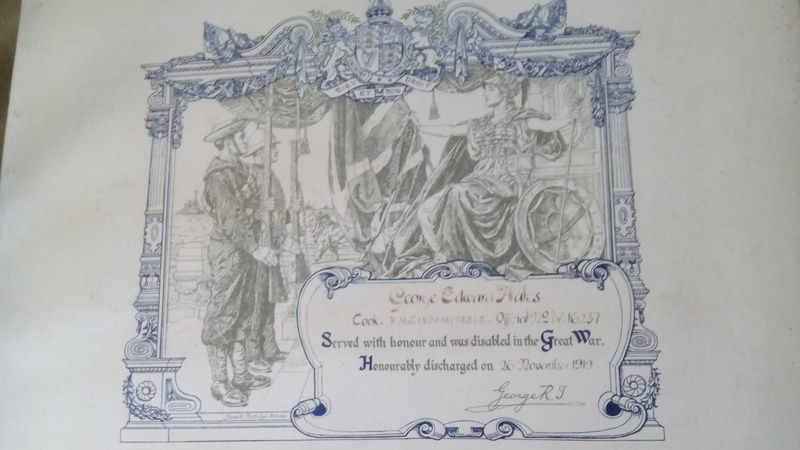
We knew my great-granddad had been in the Navy and have his Jutland service medal (as well as that of another person whose name we don't recognise) but they never mentioned anything about him being injured or disabled. He died when I was only a few years old but he never spoke or wrote about what happened, so everything aside from these two items has been consigned to history now

We knew my great-granddad had been in the Navy and have his Jutland service medal (as well as that of another person whose name we don't recognise) but they never mentioned anything about him being injured or disabled. He died when I was only a few years old but he never spoke or wrote about what happened, so everything aside from these two items has been consigned to history now
Some pictures from the German cemetery at Fricourt ( http://www.greatwar.co.uk/somme/cemetery-fricourt.... )
That has the remains of over 11,000 in one communal grave. Over half of these are unidentified.
Each cross normally signifies 4 burials, the exception being where one of those is Jewish. In those cases, there's a separate headstone.
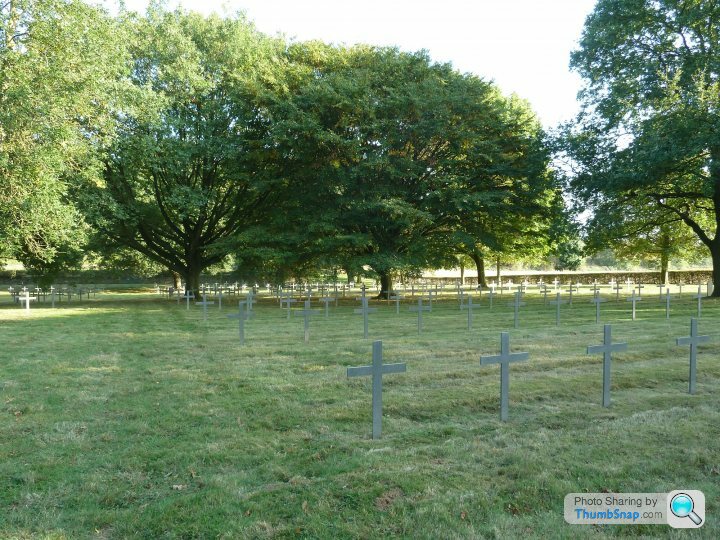
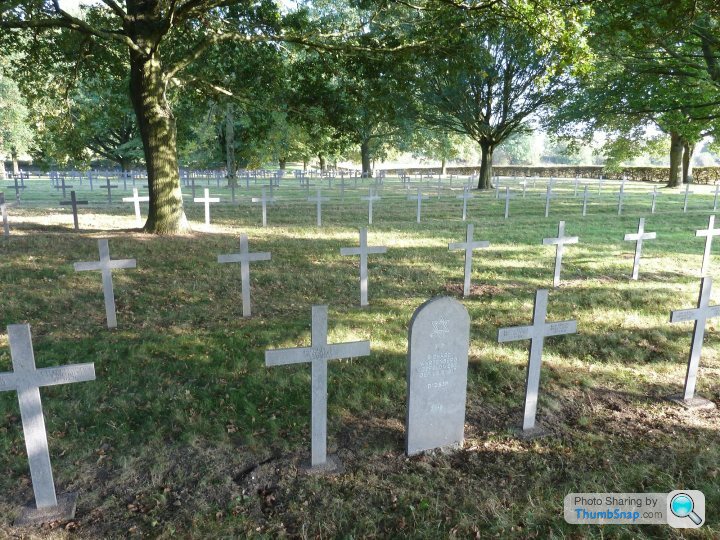
Just one panel from the communal grave, listing some of those buried beneath.
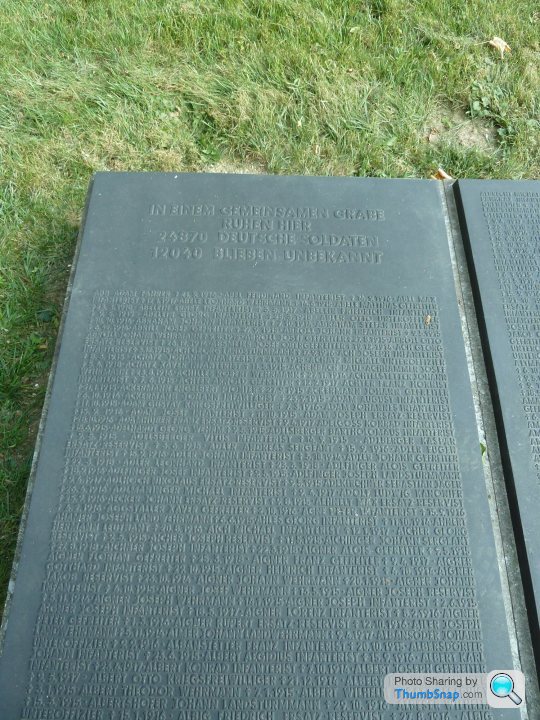
We also visited the Vladslo German cemetery - unfortunately no photos as they were in the middle of setting up a marquee for the launch of a new app which will help visitors locate a grave. This cemetery has 2 stunning sculptures created by the parents of a German soldier whose remains rest there (http://www.c20society.org.uk/war-memorials/belgium-vladslo-deutsche-soldatenfriedhof-german-military-cemetery/ ).
That has the remains of over 11,000 in one communal grave. Over half of these are unidentified.
Each cross normally signifies 4 burials, the exception being where one of those is Jewish. In those cases, there's a separate headstone.


Just one panel from the communal grave, listing some of those buried beneath.

We also visited the Vladslo German cemetery - unfortunately no photos as they were in the middle of setting up a marquee for the launch of a new app which will help visitors locate a grave. This cemetery has 2 stunning sculptures created by the parents of a German soldier whose remains rest there (http://www.c20society.org.uk/war-memorials/belgium-vladslo-deutsche-soldatenfriedhof-german-military-cemetery/ ).
Don, if you don't want this posting here, just let me know and I can delete it.
This is my great grandfather's wire cutter from 1917. It's built like a bolt cutter, but the jaws only open about half an inch. He was badly wounded in the fighting near the Belgium border, as can be seen from his cigarette case. However he recovered and lived until 1977.
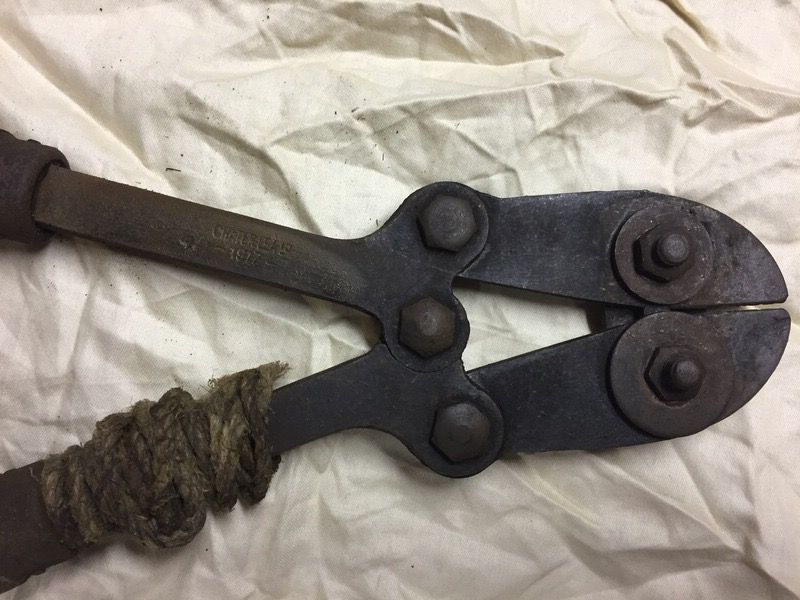

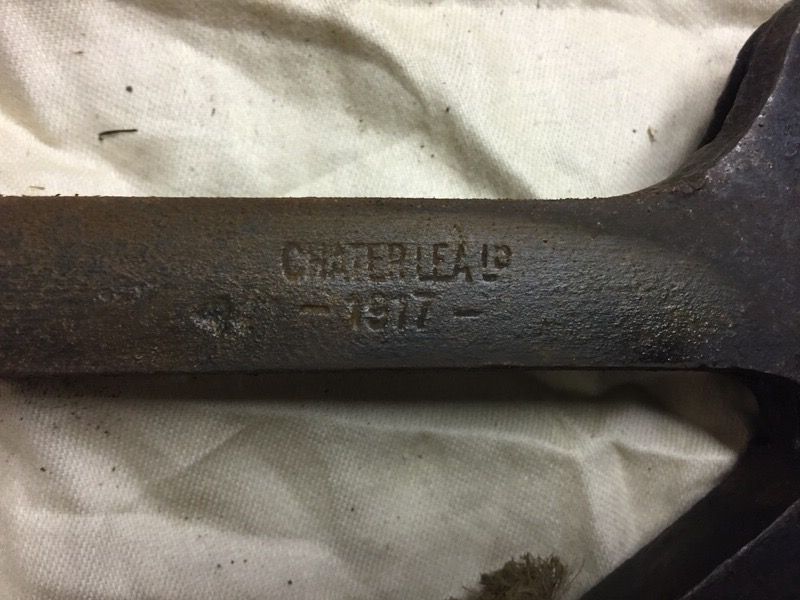

This is my great grandfather's wire cutter from 1917. It's built like a bolt cutter, but the jaws only open about half an inch. He was badly wounded in the fighting near the Belgium border, as can be seen from his cigarette case. However he recovered and lived until 1977.




RicksAlfas said:
Don, if you don't want this posting here, just let me know and I can delete it.
This is my great grandfather's wire cutter from 1917. It's built like a bolt cutter, but the jaws only open about half an inch. He was badly wounded in the fighting near the Belgium border, as can be seen from his cigarette case. However he recovered and lived until 1977.




I'm very pleased that you posted the photos. This is my great grandfather's wire cutter from 1917. It's built like a bolt cutter, but the jaws only open about half an inch. He was badly wounded in the fighting near the Belgium border, as can be seen from his cigarette case. However he recovered and lived until 1977.




So many people still feel the pain.
One of the things that I am struggling to get my head around is why the barbed wire proved to be such an obstacle. I was wondering why the British didn't have bolt cutters.
I think that I am beginning to understand why bolt cutters wouldn't have worked.
In most places, no man's land was about 200 yards. The only places where the British succeeded were where the local Generals ignored the "walk" order and instructed their men to run across no-man's land as fast as possible. As far as I can see, these places also had manageed to flatten some of the barbed wire.
When the artillery barrage stopped, the Germans took a couple of minutes to get back up to their machine gun posts. In a couple of locations the Allies were waiting for them as they came out of their dug-outs. In these places, the Germans didn't stand a chance.
don4l said:
In most places, no man's land was about 200 yards. The only places where the British succeeded were where the local Generals ignored the "walk" order and instructed their men to run across no-man's land as fast as possible. As far as I can see, these places also had manageed to flatten some of the barbed wire.
When the artillery barrage stopped, the Germans took a couple of minutes to get back up to their machine gun posts. In a couple of locations the Allies were waiting for them as they came out of their dug-outs. In these places, the Germans didn't stand a chance.
IIRC another issue was the British Generals had time limits - 3 mins to walk over, 2 mins to take objective, so at 6 mins the next barrage would take place. Therefore, any small delay (or being shot at) meant the barrage finished long before the troops arrived, giving the Germans time to deploy.When the artillery barrage stopped, the Germans took a couple of minutes to get back up to their machine gun posts. In a couple of locations the Allies were waiting for them as they came out of their dug-outs. In these places, the Germans didn't stand a chance.
One of the French generals as I understand it said "f*ck that" and got his people on the ground to inform him when they had advanced, then the artillery started up. They advanced further and with fewer casualties due to the flexibility.
So many errors, so many thousands of young men died because of them. Such a waste.
Gassing Station | The Lounge | Top of Page | What's New | My Stuff



